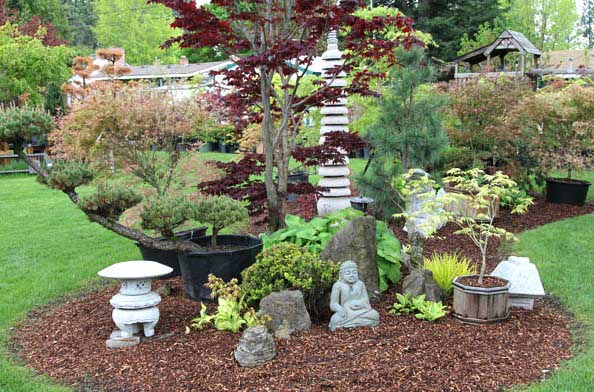Japanese gardens are revered for their tranquility, beauty, and symbolic elements. They invite nature into our lives while offering a serene retreat from the hustle and bustle of modern living. In this guide, I will share my personal experiences with Japanese garden decor and offer insights on how you can create your own peaceful oasis. Let’s explore the components that make up stunning Japanese gardens and how to incorporate these elements into your space.
Understanding Japanese Garden Aesthetics
Japanese garden decor is rooted in ancient traditions and philosophies. It emphasizes balance, simplicity, and a deep respect for nature. There are several types of Japanese gardens, each with unique characteristics:
- Karesansui (Dry Landscape) Garden: Uses rocks, gravel, and sand to symbolize water and mountains.
- Chaniwa (Tea Garden): Designed for tea ceremonies, featuring paths, stone lanterns, and stepping stones.
- Shinji (Strolling Garden): Incorporates winding paths that lead to various viewpoints and scenic elements.
- Courtyard Gardens: Small gardens within the home environment, providing a peaceful retreat.
Essential Elements of Japanese Garden Decor
1. Stones and Gravel
Stones are foundational in any Japanese garden. They symbolize strength and permanence. Gravel, on the other hand, represents water. Using these materials effectively creates the feeling of a natural landscape.
Types of Stones
When selecting stones for your garden, you might consider:
| Type of Stone | Pros | Cons |
|---|---|---|
| River Stones | Natural look, smooth surface | Can be slippery |
| Granite | Durable, elegant | Heavy, can be expensive |
| Slate | Varied colors, easy to shape | Can crack in extreme weather |

2. Water Features
Water is central to Japanese gardens, symbolizing renewal and tranquility. Consider incorporating ponds, streams, or even a simple water basin.
Popular Water Feature Ideas
- Koi Ponds: A serene addition that supports wildlife.
- Fountain: Gentle sounds evoke peace.
- Stream: Natural movement of water creates a dynamic atmosphere.
3. Plants and Trees
Greenery plays a crucial role, with careful selection of plants to create varying heights, colors, and textures. Popular options include:
- Bonsai Trees: Represent the beauty of nature in miniature.
- Maple Trees: The vibrant colors of these trees, especially in autumn, add a stunning visual element.
- Perennials: Such as ferns and azaleas, which offer lush greenery all year round.

Planting Tips
When arranging your plants, consider the concept of shakkei (borrowed scenery) to incorporate surrounding landscapes into your design.
4. Pathways and Stepping Stones
Paths guide visitors through the garden, inviting exploration. Stepping stones are a classic element, providing structure while harmonizing with nature.

- Use Natural Materials: Like wood and stone.
- Curved Paths: Mimic natural trails and soft edges.
5. Garden Decor and Accessories
Decorative elements such as lanterns, sculptures, and gates enhance the beauty and functionality of your garden.

Popular Decor Items
- Stone Lanterns: Illuminate paths and create ambiance.
- Water Basins (Tsukubai): Used for purification during tea ceremonies.
- Bridges: Symbolize the crossing between worlds.
Lighting in Japanese Gardens
Proper lighting sets the mood and enhances evening enjoyment. Incorporate subtle, soft lighting to illuminate your garden without overpowering its serenity.

Types of Garden Lighting
- Path Lights: Guide the way without being intrusive.
- Spotlights: Highlight specific features, such as trees or water.
- Lanterns: Create a traditional ambiance.
Creating a Balanced Environment
Balance is essential in Japanese garden decor. The placement and scale of elements should complement each other, ensuring a harmonious space.

Design Principles to Follow
- Asymmetry: Embrace uneven spacing to reflect the natural world.
- Layering: Create depth with varying heights and textures.
- Focal Points: Use key elements to draw the eye naturally.
Pros and Cons of Japanese Garden Decor
Pros
- Promotes relaxation and mindfulness.
- Encourages a connection with nature.
- Visually stunning and unique.
Cons
- Requires regular maintenance.
- Initial setup can be costly.
- Elements can be sensitive to climate changes.
Personal Experience: My Journey into Japanese Garden Decor
When I first ventured into designing my Japanese garden, I was overwhelmed by the choices available. I remember the joy of selecting the perfect stones and plants. I chose a beautiful maple tree as the centerpiece, and it has since become a friendly haven for birds and butterflies alike. Each season brings a new face to my garden, which I cherish deeply. The tranquility it provides makes all the effort worthwhile.
Maintenance Tips for Japanese Gardens
Maintaining your Japanese garden is crucial for preserving its beauty and serenity. Here are some practical tips:
- Regular Pruning: Keep plants healthy and ensure they maintain desired shapes.
- Weeding: Prevent invasive species from overtaking your garden.
- Cleaning Water Features: Keep ponds and fountains clear for aesthetic appeal.
FAQs About Japanese Garden Decor
What materials are ideal for building a Japanese garden?
Common materials include natural stones, gravel, wood, and bamboo.
Can I create a Japanese-style garden in a small space?
Absolutely! Miniature gardens, container gardens, and vertical plantings can all represent Japanese design principles.
How do I incorporate seasonal changes into my garden?
Selecting a variety of plants with seasonal blooms or colors can keep your garden vibrant throughout the year.
Are there any tools specific to Japanese garden maintenance?
Tools such as hand pruners, rakes for gravel, and small trowels are beneficial for maintaining a Japanese garden.
Final Thoughts
Japanese garden decor offers a unique way to experience nature’s beauty from the comfort of your home. Whether you opt for a complete redesign or a few additions, the principles of simplicity and tranquility will guide you toward a serene environment. I encourage you to explore, experiment, and make your garden a true reflection of your spirit. May you find peace and joy in your journey towards creating your very own Japanese garden!